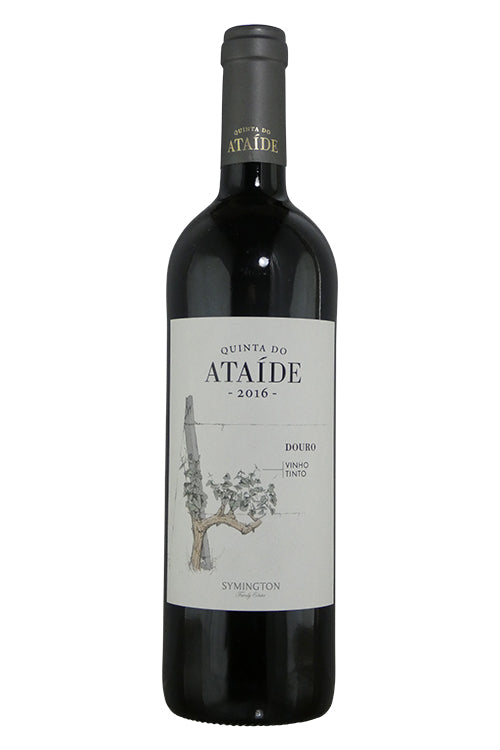1
/
of
1
Quinta do Ataide - 2016 (750ml)
Quinta do Ataide - 2016 (750ml)
Regular price
$19.99
Sale price
$19.99
Regular price
$29.99
Unit price
/
per
91 points Decanter World Wine Awards
Fresh blackcurrant leaf nose, floral bergamot,and red currant underneath. Elegantly structured palate, silky eucalyptus, cherry notes, milk chocolate tannins, spicy finish.
Tangy raspberry and ripe cherry flavors are well-spiced in this plush, medium-bodied red. Details of herb and mineral mark the energetic finish. Touriga Nacional, Touriga Franca, Tinta Barroca, Tinta Roriz and Tinta Cão. Drink now through 2025. 5,000 cases made, 1,000 cases imported. - Gillian Sciaretta
Availability:
1 In Stock
$25 Shipping on Orders +$299
Couldn't load pickup availability
Share :

- varietal
- Region
- Sub - Region
- Type
- Reviews
Product Review
This wine is the result of a selection of grapes harvested from old vines planted at different altitudes and exposures at Quinta dos Murças. Boasting a deep red hue, there are ripe fruit notes typical of the region’s grape varieties and a complex structure offered by the schist soils of the property’s terroir and the traditional vinification method (pisa a pé). After fermentation in lagar, Quinta dos Murças Reserva is matured for 12 months in French and American oak casks...This wine can be drunk immediately or left to age in the bottle for a few more years. Excellent for hearty meals, such as dishes from the Douro region (octopus lagareiro or veal à mirandesa).
Coined by Jancis Robinson as "Spain’s answer to Cabernet Sauvignon," its style varies significantly depending on terroir and the wine-making techniques used. Cooler regions and stainless steel fermentation tend to produce Tempranillos with fresh strawberry and cherry like fruit, similar in body to Pinot Noir. Examples from hotter, more arid regions that undergo extended oak aging often produce richer, plumper, jammier wines, typically exhibiting chocolate, tobacco, and leather notes. Tempranillo provides the backbone of the highly regarded wines of Rioja, Toro and Ribera del Duero. In Rioja particularly, it is typically blended with Garnacha (Grenache), Mazuelo (Carignan) and Graciano. In La Mancha and Navarra, it is commonly blended with Cabernet Sauvignon and Merlot to produce inexpensive, great-value wines. One of the few places Tempranillo has spread to is Spain’s neighbour, Portugal. Grown mainly in the Douro valley since the mid 19th century, where they call it Tinta Roriz, it is used as one of the key blending agents in port. Lately it has been used in the region's intensely rich, dry, table wines.
Port is a fortified wine originally produced in the Douro Valley in Portugal. The name is an Anglicized form of the town Oporto, where the wine is aged and from where it is shipped. The discovery of this style is credited to English wine merchants and shippers who were seeking new sources of wine during 17th century trade disputes with France. Because the wine is fortified with grape brandy, which stops the fermentation process and raises the alcohol content, it could be shipped back to England or any outpost of the empire unspoiled. Even in the 21st century British producers still dominate the industry, in particular the Taylor Fladgate partnership and the Symingtons, whose holdings include Graham, Warre, Dow, and Smith Woodhouse. Although producers in a number of New World countries, including Australia, South Africa and California have replicated the Port style, the traditional defined area within the Douro valley still produces the vast majority of Port on the world market. Ports are divided into two broad types, cask-aged and bottle-aged. Within the bottle-aged category there are two different styles. Ruby, intended for early consumption and generally the least expensive, and Vintage Port which are aged for a short time in oak (2 to 3 years) are then aged for a significant time in bottle (10 to 30+ years). There is also Single Quinta, which is generally made in non vintage years from the port houses single estate vineyards. Cask-aged Ports such as Tawny, Colheita (Tawnies from a single year) and LBVs (Late bottle vintages) do their maturing prior bottling so are ready to be consumed straightaway and do not develop further in the bottle. Although Port is normally reserved for special occasions and often consumed alongside Stilton, the use of different styles has often been neglected. White port can be a great component in cocktails and is becoming increasingly popular. Tawny ports also make a great Summer drink, often preferred by locals in the sun baked Douro valley, either as an aperitif or accompaniment to dried fruits and nuts as well as pastries.
NULL
Red wine is wine made from dark-coloured grape varieties. The color of red differs based on the grapes variety or varieties used.Interestingly, black grapes yield a juice that is greenish-white. The actual red color comes from anthocyan pigments (also called anthocyanins) from the skin of the grape (exceptions are the relatively uncommon teinturier varieties, which produce a red colored juice). Most of the production centers around the extraction of color and flavor from the grape skin.


